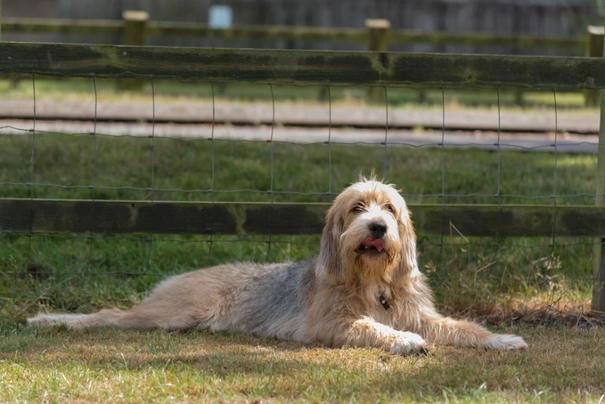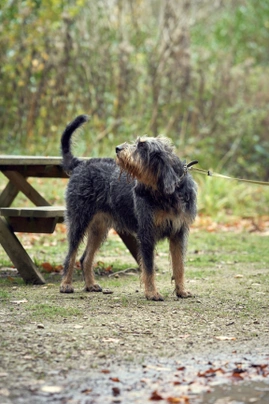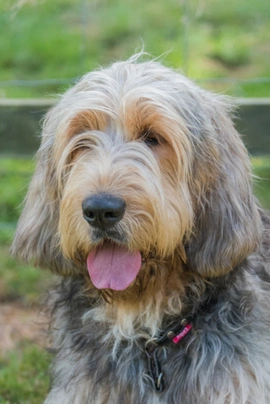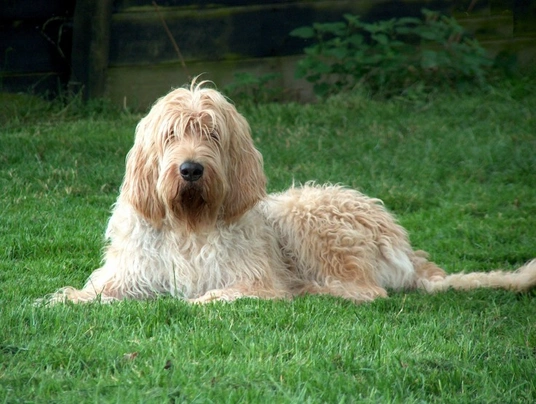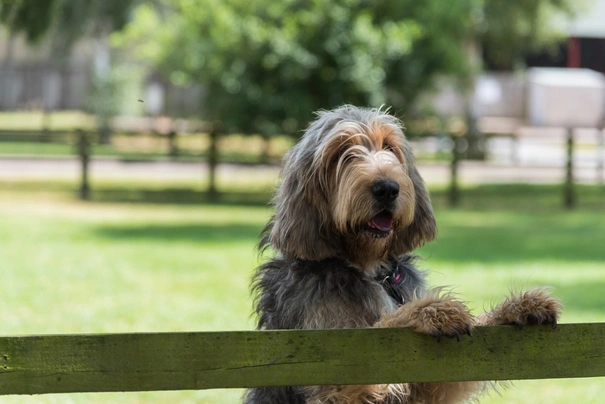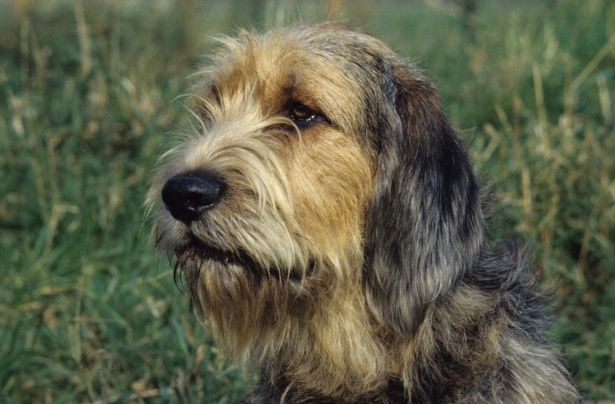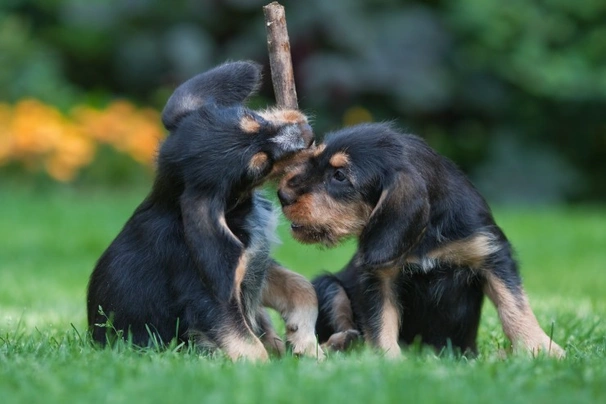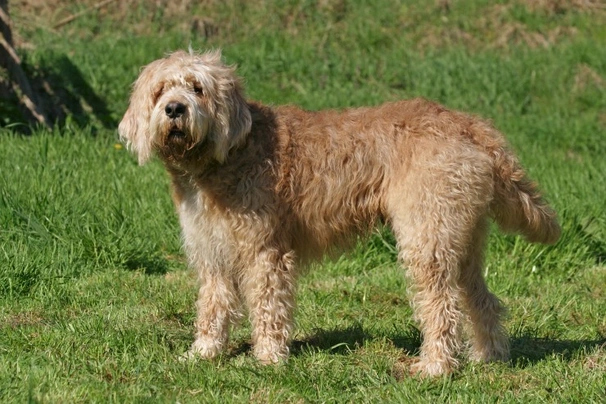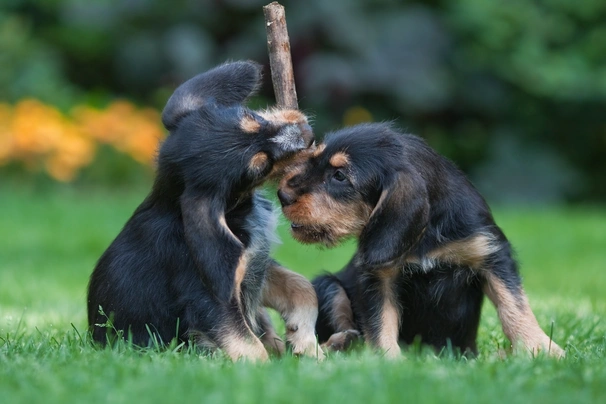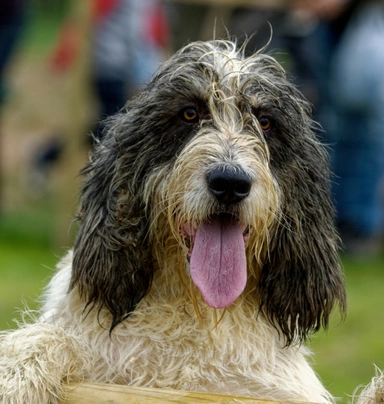Otterhound
Pros
Cons
Introduction of the Otterhound
Otterhounds are large and impressive looking dogs that boast a rather rugged look about them. They were originally bred to hunt but over time they have proved themselves to be a great choice both as companion dogs and family pets especially for people who lead active outdoor lives and who live in the country. Otterhounds are quite high-energy characters and they love nothing more than being kept busy in the great outdoors. Because they shed quite a bit and can leave muddy paw prints around the house they are therefore not the best choice for anyone who is remotely house proud. Sadly Otterhounds are one of the rarest of our native breeds with only very few puppies being registered with The Kennel Club every year and as such they have been placed on the vulnerable native breed list.
History of the Otterhound
The history of the Otterhound can be traced way back to the 12th century although much of the breed's origins remains a bit of a mystery. What is known is that these charming handsome dogs are considered to be one of the oldest British hounds on record. It's thought the breed evolved by crossing 3 other hound breeds namely the old Basset Griffon Vendeen the Southern Hound and the old St Hubert Hound.
Throughout history Otterhounds were highly prized for their hunting skills and more especially for their ability to track down otters which were considered a pest at the time. In times long past otters caused a lot of havoc with fish stocks in rivers throughout Britain and Otterhounds were used to keep their numbers under control. They were bred to be strong and extremely agile so they could take on a quick moving and heavy otter even in the water. Otterhounds are very strong swimmers and more than capable of taking on otters weighing anything up to 35 lbs.
However the Otterhound we see today is a descendant of hounds that were around during the 1700’s with a record of a rough-coated dog have been the preferred “type” right up to the 1800’s. There are records of the breed having been exhibited at a dog show in Leeds in 1861. However it was not until the beginning of the 20th Century in 1910 that the Association of Masters of Otterhounds was founded with the hounds being depicted on their flag at a show that took place in Rugby.
In the early seventies the number of otters found in rivers throughout the UK fell dramatically low and as such a conservation order was drawn up to protect them. In 1978 otter hunting was banned in England. Two years later otter hunting was banned in Scotland too. With this the two remaining Otterhound packs united to ensure that the breed did not vanish altogether because their numbers had fallen so low Otterhounds were on the brink of extinction.
Today although these handsome hounds are not as popular as they once were and the breed has been placed on The Kennel Club's vulnerable native breed list enthusiasts are making sure that Otterhounds will find new tasks apart from being wonderful family pets and companions which includes working as drug detector dogs amongst other things.
Interesting facts about the breed
- Is the Otterhound a vulnerable breed? Yes they have been placed on the Kennel Club’s list of vulnerable native breeds and very few puppies are bred and registered with the Kennel Club every year
- The Otterhound is one of the UK’s most ancient scent hounds. The first record being that made during Henry II’s reign (1100’s)
- Otterhounds have very distinct voices and bay when the mood takes them or to show they have found their prey
- Contrary to belief an Otterhound does not need to be given a tremendous amount of physical daily exercise
- Waiting lists for Otterhounds are long and well-bred puppies can often command a lot of money
Appearance of the Otterhound
Height at the withers: Males 69 cm Females 61 cm
Average weight: Males 52 kg Females 36 kg
The Otterhound is a large and impressive looking dog that boasts quite a rugged appearance about them. Their heads are clean cut and quite imposing being rather deep and not that wide. Dogs have nicely domed heads and a well-defined stop. Muzzles are deep and strong with a nice wide nose and nostrils. Otterhounds have lots of lip and flew and their entire heads with the exception of their nose are covered with rough hair which is finished off nicely with a little moustache and beard on their muzzles.
Their eyes are quite deeply set with dogs boasting an intelligent expression in them. The colour of their eyes matches their coat which sees blue and tan coated hounds having hazel coloured eyes. Their ears are a unique physical trait for the breed being long and pendulous set in line with the corner of a dog's eye and having a characteristic fold in them. Ears are well covered and fringed with hair. The Otterhound has a strong jaw with a perfect scissor bite where their upper teeth neatly overlap their lower ones.
Their necks are long powerful and flow smoothly into a dog's well laid-back shoulders. Dogs are allowed to have a slight dewlap. Their shoulders are well laid back and their front legs are straight nicely boned and strong. Their chests are deep with dogs having well sprung and fairly deep oval ribcages. Their body is strong with a level topline and nice broad powerful back with short strong loins.
Back legs are extremely strong and well-muscled with dogs boasting well-muscled thighs and second thighs. Feet are round and large being well-knuckled and thickly padded. Their back feet are a little smaller in size than their front ones but all four feet are nicely webbed. Tails are set high and dogs carry them up when excited or alert but when relaxed their tails droop down. The hair on the underside of their tail is longer and a lot more profuse than it is on the top of it.
When it comes to their coat the Otterhound has a double coat that consists of a rougher dense and harsh topcoat that's extremely waterproof being slightly oily in texture and which has a broken appearance. The undercoat is much softer and has a slightly oily feel to it. The hair is softer on a dog's head and on the lower part of their legs than it is on the rest of their body. The accepted breed colours for Kennel Club registration are as follows:
- Black & Blue
- Black & Tan
- Grizzle & White
- Liver & Tan
- Particolour
- Red Grizzle
- White & Black
It is worth noting that the accepted breed colours for Kennel Club registration can differ from those set out in the breed standard. All hound colours that are recognised are permissible which are as follows:
- Whole coloured
- Grizzle
- Sandy
- Red
- Wheaten
- Blue
- White
- Black and tan
- Blue and tan
- Liver
- Tan and liver
- Tan and white
- Otterhounds can have a little white on their heads chests feet and on the tips of their tails. White coated Otterhounds can have a little lemon blue or badger pied markings in their coats.
A dog’s pigment should match their coat colour although not necessarily and a slight butterfly nose is allowed under the breed standard.
The colours that are not permissible under the Otterhound Kennel Club breed standard are as follows:
- Liver and white
- White-bodies with black and tan patches distinctly separate
Gait/movement
When an Otterhound moves they do so with a loose shambling gait at the walk which quickly turns into a springy gait when they pick up speed taking long strides and covering a lot of ground when they do. At the gallop their gait is very smooth.
Faults
The Kennel Club frowns on any exaggerations or departures from the breed standard and would judge the faults on how much they affect a dog's overall health and wellbeing as well as their ability to perform.
Males should have both testicles fully descended into their scrotums and it is worth noting that a dog can be a little lighter or heavier as well as slightly taller or shorter than set out in the Kennel Club breed standard which is only given as a guideline.
Temperament of the Otterhound
Otterhounds are known to be friendly and affectionate although at times they can be a little boisterous especially when they are puppies or going through their adolescent stage. They love being in a home environment being part of the family and becoming valuable members of a household. They are generally good around all people and children although their sheer size means they might accidentally knock a toddler over and frighten them. With this said Otterhounds are known to be even-tempered and placid dogs that are a joy to be around. Much like other hounds the Otterhound does have bit of a wilful streak in them which means their training has to start early and it has to be consistent from the word go right through a dog's life in order to get the best results.
Are they a good choice for first time owners?
Otterhounds are not the best choice for first time owners because training them requires a lot of patience and understanding which is best left up to people who are familiar with the needs of an intelligent independent thinking scent hound that likes to be kept busy. They must be socialised handled and trained by people who understand the breed’s needs when it comes to mental stimulation and daily physical exercise. They are not the best choice for people who are very house proud either.
What about prey drive?
Otterhounds do not “chase” things but they are always willing to “investigate” anything that crosses their path more out of curiosity than anything. As such they do not have a high prey drive unlike sighthounds that will chase anything that moves.
What about playfulness?
Otterhounds have a very playful side to their natures and love to entertain and be entertained more especially when very young. They are known to be a little mischievous when the mood takes them and being so clever an Otterhound quickly learns how to please an owner and how to get their own way when they want something.
What about adaptability?
Otterhounds are better suited to people who have large well-fenced secure back gardens a dog can safely roam in whenever possible to really let off steam. They are large scent hounds that need enough space to express themselves both indoors and when they are outdoors in a garden.
What about separation anxiety?
Although Otterhounds form strong ties with their families and love the company of people they are not typically known to suffer from separation anxiety providing they are not left to their own devices for too long.
What about excessive barking?
Otterhounds have a lovely deep impressively low bark but they are not known to be “barkers” and will only voice an opinion when asked or when they find themselves in the company of other Otterhounds when they will happily join in a howling chorus being careful to stay in tune with each other as they sing along.
Do Otterhounds like water?
Otterhounds love being in and around water thanks to their breeding. However if anyone who owns a dog that does not like water should never force them to go in because it would just end up scaring them. With this said care should always be taken when walking an Otterhound off the lead anywhere near more dangerous watercourses just in case a dog decides to leap in and then needs rescuing because they cannot get out of the water on their own.
Are Otterhounds good watchdogs?
Otterhounds are not natural watchdogs although this is not to say a dog would not be quick off the mark to let an owner know when there are strangers about although they would rarely do this aggressively preferring to keep their distance stand their ground and voice an opinion with their deep and impressive barks.
Intelligence / Trainability of the Otterhound
Otterhounds like many other scent hounds are known to be very sensitive by nature and they have an extremely strong sense of hierarchy when it comes to their “packs”. As such without the right kind of direction and guidance an Otterhound is very likely to assume the position of top dog. With this said being so intelligent Otterhounds are quick to learn new things with many taking part in agility and obedience because they are such “all-rounders”.
As such in the right hands and with the right amount of early socialisation and training Otterhounds are quite easy to train. However like many other hounds they are known to be sensitive dogs by nature and as such they do not answer well to any sort of harsh correction or heavy-handed training methods. They do however respond well to voice and positive reinforcement. With this said their training has to be consistent and always fair in order to get the best results.
Otterhounds have a real sense of humour and are known as natural clowns which although highly amusing it can make keeping them focused on their training a little bit of a challenge which is just one of the reasons they are not a good choice for novice owners. However even the best trained Otterhound might choose to ignore a recall command if they pick up a more interesting scent and as such care has to be taken as to where a dog is allowed to run off the lead.
Like all puppies Otterhounds are incredibly cute when young and it is all too easy to spoil them when they first arrive in new homes. As soon as a puppy is nicely settled owners must start out as they mean to go on by laying down ground rules and boundaries so that a puppy understands what is expected of them. It helps establish a pecking order and who the alpha dog is in the household. The first commands a puppy should be taught are as follows:
- Come
- Sit
- Stay
- Heel
- Quiet
- Leave it
- Down
- Bed
Children and other
Otterhounds seem to have an affinity with children of all ages but thanks to their size care has to be taken when they are around toddlers just in case they knock a child over and it scares them. Any interaction between children and dogs should be supervised by an adult to make sure playtime does not get too boisterous.
They will usually get on well with other dogs and animals as long as they have been well socialised from a young age. However care has to be taken when an Otterhound meets smaller animals and pets because their instincts might kick in with disastrous results. If an Otterhound has grown up with a cat in the home they will generally get on well together but these dogs would see any other cats as "fair game".
Health of the Otterhound
The average life expectancy of an Otter Hound is between 10 and 13 years when properly cared for and fed an appropriate good quality diet to suit their ages.
Like so many other breeds the Otterhound is known to suffer from a few hereditary health issues which are worth knowing about if you are planning share your home with one of these active and good-looking dogs. The conditions that seem to affect the breed the most include the following:
- Hip dysplasia – dogs should be hip scored through the BVA/KC hip dysplasia scheme
- Elbow dysplasia – dogs should be elbow tested through the BVA/KC elbow scheme
- Epilepsy – advice should be sought from the Breed Club
- Degenerative Myelopathy (DM) - DNA test available through the Animal Health Trust (AHT)
- Glanzmann’s Thrombasthenia (GT) Type 1 - DNA test available through the Animal Health Trust (AHT)
- Lymphosarcoma
- Hemangiosarcoma
- Auto-immune Disease (ears and skin)
- Sebaceous Cysts
- Heart Disease
- Bloat/gastric torsion
What about vaccinations?
Otterhound puppies would have been given their initial vaccinations before being sold but it is up to their new owners to make sure they have their follow-up shots in a timely manner with the vaccination schedule for puppies being as follows:
- 10 -12 weeks old bearing in mind that a puppy would not have full protection straight away but would be fully protected 2 weeks after they have had their second vaccination
There has been a lot of discussion about the need for dogs to have boosters. As such it's best to talk to a vet before making a final decision on whether a dog should continue to have annual vaccinations which are known as boosters.
What about spaying and neutering?
A lot of vets these days recommend waiting until dogs are slightly older before spaying and neutering them which means they are more mature before undergoing the procedures. As such they advise neutering males and spaying females when they are between the ages of 6 to 9 months old and sometimes even when a dog is 12 months old.
Other vets recommend spaying and neutering dogs when they are 6 months old but never any earlier unless for medical reasons. With this said many breeds are different and it is always advisable to discuss things with a vet and then follow their advice on when a dog should be spayed or neutered.
What about obesity problems?
As with other breeds some Otterhounds gain weight after they have been spayed or neutered and it's important to keep an eye on a dog's waistline just in case they do. If a dog starts to put on weight it's important to adjust their daily calorie intake and to up the amount of exercise they are given. Older dogs too are more prone to gaining weight and again it's essential they be fed and exercised accordingly because obesity can shorten a dog's life by several years. The reason being that it puts a lot of extra strain on a dog's internal organs including the heart which could prove fatal.
What about allergies?
Some Otterhounds are prone to suffering from allergies and it's important for a dog to see a vet sooner rather than later if one flares up. Allergies can be notoriously hard to clear up and finding the triggers can be challenging. With this said a vet would be able to make a dog with an allergy more comfortable while they try to find out the triggers which could include the following:
- Certain dog foods that contain high levels of grains and other cereal-type fillers
- Airborne pollens
- Dust mites
- Environment
- Flea and tick bites
- Chemicals found in everyday household cleaning products
Participating in health schemes
All responsible Otterhound breeders would ensure that their stud dogs are tested for known hereditary and congenital health issues known to affect the breed by using the following schemes:
- Hip scoring through the BVA/KC hip dysplasia scheme with the breed’s mean score being 45.5
- Elbow testing through the BVA/KC elbow testing scheme
- Epilepsy/fitting advice from the breed club
- DNA test for Glanzmann’s Thrombasthenia (GT) Type 1 through the Animal Health Trust (AHT)
- DNA test for Degenerative Myelopathy (DM) through the Animal Health Trust (AHT)
What about breed specific breeding restrictions?
Apart from the standard breeding restrictions that are in place for all Kennel Club registered breeds there are no other breed specific breeding restrictions in place for the Otterhound.
What about Assured Breeder Requirements?
It is mandatory for all Kennel Club Assured breeders to use the following tests on their dogs and all other breeders are strongly advised to follow suit:
- BVA/KC Hip Dysplasia Scheme – the breed mean score is currently 45.5 which is very high – parent dogs should be as low as possible
- BVA/KC Elbow Dysplasia Scheme
The Kennel Club also strongly recommends that all breeders request the following advice from Otterhound breed club:
- Breed Club - advice on epilepsy/fitting
It is worth noting that the breed average COI for Otterhounds as stated by The UK Kennel Club currently stands at 17.7%.
Caring for the Otterhound
As with any other breed Otterhounds need to be groomed on a regular basis to make sure their coats and skin are kept in top condition. They also need to be given regular daily exercise to ensure they remain fit and healthy. On top of this dogs need to be fed good quality food that meets all their nutritional needs throughout their lives.
Caring for an Otterhound puppy
Otterhound puppies are boisterous and full of life which means it's essential for homes and gardens to be puppy-proofed well in advance of their arrival. A responsible breeder would have well socialised their puppies which always leads to more outgoing confident and friendly dogs right from the word go. With this said any puppy is going to feel vulnerable when they leave their mother and littermates which must be taken into account. The longer a puppy can remain with their mother the better although it should never be for too long either.
It's best to pick a puppy up when people are going to be around for the first week or so which is the time needed for a puppy to settle in. Puppy-proofing the home and garden means putting away any tools and other implements that a boisterous puppy might injure themselves on. Electric wires and cables must be put out of their reach because puppies love chewing on things. Toxic plants should be removed from flowerbeds and the home too.
Puppies need to sleep a lot to grow and develop as they should which means setting up a quiet area that's not too out of the way means they can retreat to it when they want to nap and it's important not to disturb them when they are sleeping. It's also a good idea to keep "playtime" nice and calm inside the house and to have a more active "playtime" outside in the garden which means puppies quickly learn to be less boisterous when they are inside.
The documentation a breeder provides for a puppy must have all the details of their worming date and the product used as well as the information relating to their microchip. It is essential for puppies to be wormed again keeping to a schedule which is as follows:
- Puppies should be wormed at 6 months old
- They need to be wormed again when they are 8 months old
- Puppies should be wormed when they are 10 months old
- They need to be wormed when they are 12 months old
Things you'll need for your puppy
There are certain items that new owners need to already have in the home prior to bringing a new puppy home. It's often a good idea to restrict how much space a puppy plays in more especially when you can't keep an eye on what they get up to bearing in mind that puppies are often quite boisterous which means investing in puppy gates or a large enough playpen that allows a puppy the room to express themselves while keeping them safe too. The items needed are therefore as follows:
- Good quality puppy or baby gates to fit on doors
- A good well-made playpen that's large enough for a puppy to play in so they can really express themselves as puppies like to do
- Lots of well-made toys which must include good quality chews suitable for puppies to gnaw on bearing in mind that a puppy will start teething anything from when they are 3 to 8 months old
- Good quality feed and water bowls which ideally should be ceramic rather than plastic or metal
- A grooming glove
- A slicker brush or soft bristle brush
- Dog specific toothpaste and a toothbrush
- Scissors with rounded ends
- Nail clippers
- Puppy shampoo and conditioner which must be specifically formulated for use on dogs
- A well-made dog collar or harness
- A couple of strong dog leads
- A well-made dog bed that's not too small or too big
- A well-made dog crate for use in the car and in the home that's large enough for a puppy to move around in
- Baby blankets to put in your puppy's crate and in their beds for when they want to nap or go to sleep at night
Keeping the noise down
All puppies are sensitive to noise including Otterhound puppies. It's important to keep the noise levels down when a new puppy arrives in the home. TVs and music should not be played too loud which could end up stressing a small puppy out making them withdrawn timid and shy.
Keeping vet appointments
As previously mentioned Otterhound puppies would have been given their first vaccinations by the breeders but they must have their follow up shots which is up to their new owners to organise. The vaccination schedule for puppies is as follows:
- 10 -12 weeks old bearing in mind that a puppy would not have full protection straight away but would only be fully protected 2 weeks after they have had their second vaccination
When it comes to boosters it's best to discuss these with a vet because there is a lot of debate about whether a dog really needs them after a certain time. However if a dog ever needed to go into kennels their vaccinations would need to be fully up to date.
What about older Otterhound when they reach their senior years?
Older Otterhounds need lots of special care because as they reach their golden years they are more at risk of developing certain health concerns. Physically a dog's muzzle may start to go grey but there will be other noticeable changes too which includes the following:
- Coats become coarser
- A loss of muscle tone
- They can either become overweight or underweight
- They have reduced strength and stamina
- Older dogs have difficulty regulating their body temperature
- They often develop arthritis
- Immune systems do not work as efficiently as they once did which means dogs are more susceptible to infections
- Older dogs change mentally too which means their response time tends to be slower as such they develop the following:
- They respond less to external stimuli due to impaired vision or hearing
- They tend to be a little pickier about their food
- They have a lower pain threshold
- Become intolerant of any change
- Often an older dog can feel disorientated
Living with an Otterhound in their golden years means taking on a few more responsibilities but these are easily managed and should include looking at their diet the amount of exercise they are given how often their dog beds need changing and keeping an eye on the condition of their teeth.
Older dogs need to be fed a good quality diet that meets their needs at this stage of their lives all the while keeping a close eye on a dog's weight. A rough feeding guide for older dogs is as follows bearing in mind they should be fed highly digestible food that does not contain any additives:
- Protein content should be anything from 14 – 21%
- Fat content should be less than 10%
- Fibre content should be less than 4%
- Calcium content should be 0.5 – 0.8%
- Phosphorous content should be 0.4 – 0.7%
- Sodium content should be 0.2 – 0.4%
Older dogs don't need the same amount of daily exercise as a younger dog but they still need the right amount of physical activity to maintain muscle tone and to prevent a dog from putting on too much weight. All dogs need access to fresh clean water and this is especially true of older dogs when they reach their golden years because they are more at risk of developing kidney disorders.
Grooming of the Otterhound
Although their coats look like they may be high maintenance keeping an Otterhound's coat looking tidy is quite easy. Having said this because of the texture of their hair Otterhounds tend to pick up all sorts of things when out on a walk which includes twigs and thorns which would need to be brushed out straight away. Apart from that a thorough weekly grooming session is all it really takes to keep their coats tidy and their skin in good condition.
It's also important to check a dog's ears on a regular basis and to clean them when necessary. If too much wax is allowed to build up in a dog's ears it can lead to a painful infection which can be hard to clear up. In short prevention is often easier than cure when it comes to ear infections.
Exercise of the Otterhound
Although Otterhounds are known to be quite laid-back characters by nature they still need to be given the right amount of daily exercise and mental stimulation for them to be truly happy well-rounded dogs. As such they need a minimum of an hour's exercise every day and ideally this should be even more because there is nothing an Otterhound enjoys more are frequent long walks through the countryside or out on the moors. Many owners prefer to keep their Otterhounds on a lead when out walking them although as a dog matures they can run free in a safe environment bearing in mind that when the ground is wet that’s when an Otterhound will more easily pick up a scent.
A shorter walk in the morning would be fine but a longer more interesting one in the afternoon is a must. These dogs also like to be able to roam around a back garden as often as possible so they can really let off steam. However the fencing has to be extremely secure to keep these active dogs in because if they find a weakness in the fence they will soon escape out and get into all sorts of trouble.
With this said Otterhound puppies should not be given too much exercise because their joints and bones are still growing and too much pressure on them could result in causing a dog a few problems later on in their lives. They should not be allowed to jump up or off furniture nor should they be allowed to run up and down the stairs because this puts too much pressure on their still growing joints and limbs.
Feeding of the Otterhound
If you get an Otterhound puppy from a breeder they would give you a feeding schedule and it's important to stick to the same routine feeding the same puppy food to avoid any tummy upsets. You can change a puppy's diet but this needs to be done very gradually always making sure they don't develop any digestive upsets and if they do it's best to put them back on their original diet and to discuss things with the vet before attempting to change it again.
Older dogs are not known to be fussy or finicky eaters but this does not mean you can feed them a lower quality diet. It's best to feed a mature dog twice a day once in the morning and then again in the evening making sure it's good quality food that meets all their nutritional requirements. It's also important that dogs be given the right amount of exercise so they burn off any excess calories or they might gain too much weight which can lead to all sorts of health issues. Obesity can shorten a dog's life by several years so it's important to keep an eye on their waistline from the word go.
Because Otterhounds have been known to suffer from bloat it is really important that they be fed twice a day instead of giving them just one larger meal a day. It's also a good idea to invest in a stand to place their feed bowl which makes it easier for these large dogs to eat comfortably without having to stretch their necks down low to reach their food. Dog should not be exercised just before or just after they have eaten either because this puts them more a risk of suffering from bloat which could prove fatal if not treated as an emergency.
Feeding guide for an Otterhound puppy
Puppies need to be fed a highly nutritious good quality diet for them to develop and grow as they should. As a rough guide a Otterhound puppy can be fed the following amounts every day making sure their meals are evenly spread out throughout the day and it's best to feed them 3 or 4 times a day:
- 2 months old - 274g to 317g depending on puppy's build
- 3 months old - 344g to 413g depending on puppy's build
- 4 months old - 374g to 455g depending on puppy's build
- 5 months old - 413g to 537g depending on puppy's build
- 6 months old - 450g to 609g depending on puppy's build
- 7 months old - 450g to 610g depending on puppy's build
- 8 months old - 419g to 606g depending on puppy's build
- 9 months old - 391g to 566g depending on puppy's build
- 10 months old - 356g to 530g depending on puppy's build
- 11 months old - 323g to 485g depending on puppy's build
- 12 months old - 321g to 443g depending on puppy's build
- 13 months old - 320g to 440g depending on puppy's build
- 14 months old - 318g to 436g depending on puppy's build
Once a puppy is 15 months old they can be fed adult dog food.
Feeding guide for an adult Otterhound
Once fully mature an adult Otterhound should be fed a good quality diet to ensure their continued good health. As a rough guide an adult dog can be fed the following amounts every day:
- Dogs weighing 36 kg can be fed 337g to 443g depending on activity
- Dogs weighing 45 kg can be fed 409g to 538g depending on activity
- Dogs weighing 52 kg can be fed 419g to 548g depending on activity
Otterhound price
If you are looking to buy an Otterhound you may have to go on a waiting list because not many puppies are registered with The Kennel Club every year. You would need to pay anything upwards of £700 for a well-bred pedigree puppy. The cost of insuring a male 3-year-old Otterhound in northern England would be £28.15 a month for basic cover but for a lifetime policy this would set you back £66.87 a month (quote as of May 2018). When insurance companies calculate a pet's premium they factor in several things which includes where you live in the UK and a dog's age and whether they have been neutered or spayed amongst other things.
When it comes to food costs you need to buy the best quality food whether wet or dry to feed your dog throughout their lives making sure it suits the different stages of their lives. This would set you back between £30 - £40 a month. On top of this you would need to factor in veterinary costs if you want to share your home with an Otterhound and this includes their initial vaccinations their annual boosters the cost of neutering or spaying your dog when the time is right and their yearly health checks all of which quickly adds up to over a £1000 a year.
As a rough guide the average cost to keep and care for an Otterhound would be between £60 to £110 a month depending on the level of insurance cover you opt to buy for your dog but this does not include the initial cost of buying a well-bred healthy Kennel Club registered pedigree Otterhound puppy.
Buying advice
When visiting and buying any puppy or dog there are many important things to consider and questions to ask of the breeder/seller. You can read our generic puppy/dog advice here which includes making sure you see the puppy with its mother and to verify that the dog has been wormed and microchipped.
It can prove difficult when it comes to finding Otterhound puppies because so few are bred and registered with the Kennel Club every year which means that well-bred puppies can often command a lot of money. As such with Otterhounds there is specific advice questions and protocols to follow when buying a puppy which are as follows:
- Prospective owners may come across online and other adverts showing images of adorable Otterhound puppies for sale. However the sellers ask buyers for money up front before agreeing to deliver a puppy to a new home. Potential buyers should never buy a puppy unseen and should never pay a deposit to a seller before collecting a puppy from them
- As previously touched upon finding well-bred Otterhound puppies can be challenging with few being bred and registered with the Kennel Club every year. As such a few amateur breeders/people breed from a dam far too often to make a quick profit without caring for the welfare of the puppies their dam or the breed in general. Under Kennel Club rules a dam can only produce 4 litters and she must be between a certain age to do so. Anyone wishing to buy an Otterhound puppy should think very carefully about who they purchase their puppy from and should always ask to see the relevant paperwork pertaining to a puppy's lineage their vaccinations and their microchipping
